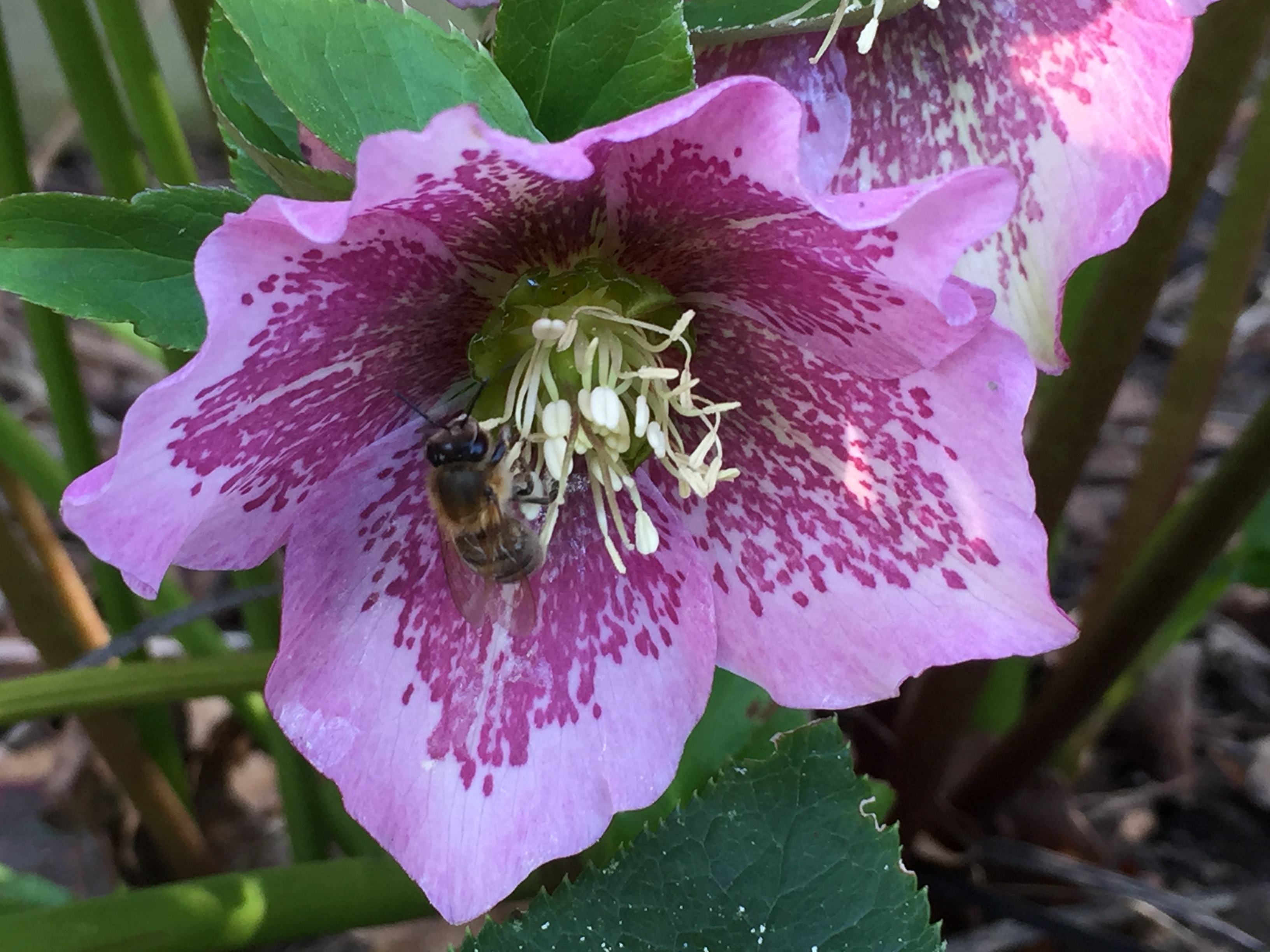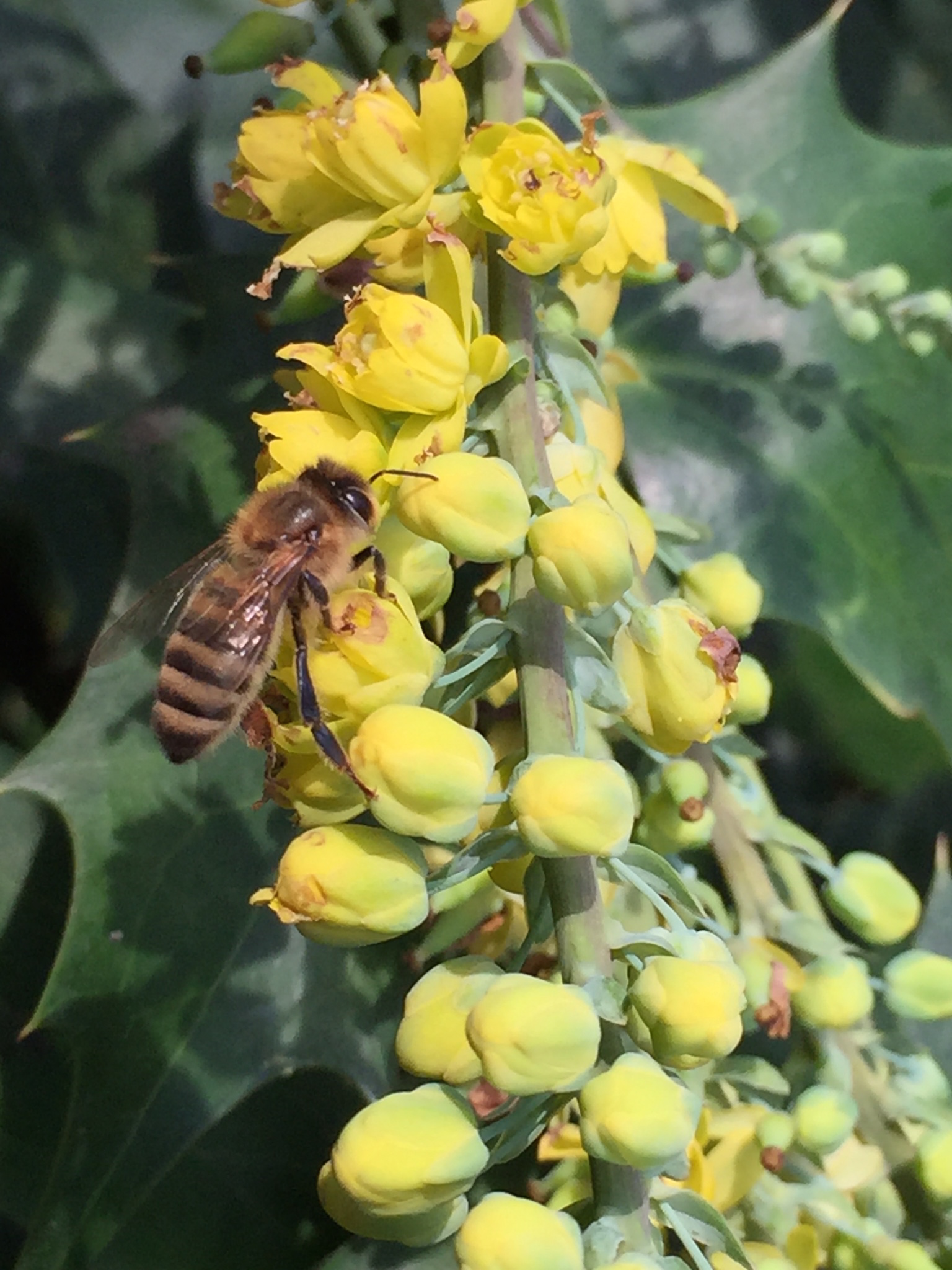| | What's in Flower in February
 Hellebore.  Mahonia.
[What's in flower, month by month]
Mark Patterson
LBKA Forage Officer
There are valuable pollen sources that are making an appearance in February.
Winter Aconites (Eranthis hyemalis>) are beginning to appear. Their bright lemon yellow flowers are attractive to bees which will collect their pollen. They are members of the Buttercup family.
In gardens hellebores> are also flowering, offering much needed pollen. Hellebores come in a wide variety of colours. The hybrid hellebores are particularly hardy and easy to grow as are the native stinking hellebores (Helleborus foetidus) which can be found in gardens and in wild areas too.
Winter heliotrope (Petasites fragrans) is a relative of our native Butterbur but flowers much earlier. It's not a UK native and can be quite invasive when established in the wild but is a great garden plant for bees in late winter. The flowers are shaped like a toilet brush and pink in colour.
The first daffodils (Narcissus sp.) are beginning to bloom. Despite their attractive flowers, daffodils and other narcissii are poor forage for bees. I have never seen a Honey Bee visit them and only occasionally have I seen desperate Bumblebees alight on them.
Wallflowers (>Erysimum) are flowering now and will continue to do so right through till late spring. Bees will visit both the popular bedding type wallflowers as well as the longer-lived everlasting perennial types. Their purple and orange `bowls' are particularly good for bees as they have a very long flowering period and will bloom almost continuously all year round.
Off the ground there are several shrubs and small trees which are now flowering and these may offer rewards of nectar on warm days alongside the pollen they produce. These include
Mahonia or Oregon Grape which grows in our towns and cities in abundance and flowers throughout the winter providing nectar and pollen for bees. In southern towns and cities Buff Tailed bumblebees (Bombus terrestris) continue to be increasingly active throughout the winter, surviving largely on this plant. Around 75\% of winter flowers visited by bees are Mahonia. The variety `winters sun' is particularly attractive. Bees taking advantage of Mahonia blooms in winter have few other insects to compete with and can fare better than some colonies active in summer.
Viburnum shrubs include a number of deciduous and evergreen species which flower during the winter months. They are relatives of our native Guelder Rose (Viburnum opolus). Some of bees' most popular Virburnums include the evergreen Viburnum tinus whose sweetly scented cream blooms flower from November through to March, and Viburnum bodnaatense whose pink flowers bloom from around Christmas to March.
Several Clematis species are useful forage sources to bees in winter. Clematis amandii and Clematis cirhossa both have creamy white flowers and bloom in winter. Honey and winter active bumble bees will visit them for pollen.
Winter Flowering Cherry (Prunus subhirtella) flowers from late November to February producing pale pink flowers. I've very rarely seen any bees on the blooms but have often seen flies on them. In the absence of better forage like Mahonia bees will visit the flowers.
Sweet Box (Sarcococca confusa) is a short growing evergreen shrub which produces extremely fragrant blooms (reminiscent of hyacinths) from late winter into early spring. It's one of those plants that you almost always smell long before you see it.
Winter Heather (Heaths Erica sp.) produce tubular blooms in shades of white to pink throughout the winter. They are coming to the end of their flowering period now but still providing forage for bees brave enough to venture out.
Winter flowering Honeysuckle flower during winter, some of which are climbers and some are shrubs. One of the best is Lonicera fragrantissimima.
Daphne shrubs are beginning to flower now and their intense perfume-like scent will attract bees to collect their pollen.
Hazel (Corylus avellana) is flowering now and the long male catkins drip with pollen. On warm days Honeybees may visit the catkins to collect pollen, though the plants are wind pollinated and do not need the bees to reproduce.
Other trees that produce catkins may start to make an appearance in February include willows (Salix sp.) and poplars (Populus sp.) though they are usually a little later flowering.
|



